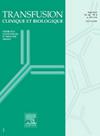一项随机对照临床试验,比较三级护理医院中随机输血与配方输血的临床结果。
IF 1.2
4区 医学
Q4 HEMATOLOGY
引用次数: 0
摘要
背景和目的:红细胞输注是治疗贫血的主要方法,输注足够剂量的红细胞以维持组织需氧量非常重要。此外,避免红细胞超载以防止不良反应也很重要。因此,我们比较了随机输血(RBT)和配方输血(FBBT)患者血红蛋白和红细胞压积的升高,以更好地了解两种方法在临床结果上的差异。材料和方法:本研究纳入752例住院并需要输血1单位PRBC的患者。纳入研究的患者随机分为RBT和FBBT两类,采用分层随机抽样,无偏倚。在RBT类别中,患者根据标准做法接受输血,即患者接受完整的红细胞单位,而体积没有任何改变。所有在研究期间在交叉匹配登记表中提出奇数请求且符合资格的受试者均纳入本组。在FBBT组中,交叉匹配寄存器中的偶数请求随机接受FBBT。在这一类中,患者接受输血的公式如下:需要输血的红细胞体积= TBV ×(期望Hct -患者当前Hct)/供体单位Hct(期望Hct上升3%)结果:在我们的研究中,我们发现接受FBBT的患者血红蛋白和红细胞压积水平的上升明显高于接受RBT的患者。输血前血红蛋白和红细胞压积没有显著差异,而输血后血红蛋白和红细胞压积在FBBT组比RBT组有更高的上升。(Welch校正t = 2.633, p值= 0.0086)。结论:本研究再次强调了FBBT比常规RBT的价值。本研究发现,FBBT比RBT有优势,输血后Hb和Hct的增加明显更高。因此,作者认为可以考虑在常规临床实践中使用FBBT来优化患者的输血。本文章由计算机程序翻译,如有差异,请以英文原文为准。
A randomized controlled clinical trial to compare the clinical outcome of random-based versus formula-based blood transfusion in a tertiary care hospital setting
Background and objectives
Red cell transfusion is the mainstay of therapy for anemia and it is important to transfuse adequate dosage of red cells to maintain tissue oxygen demands. Additionally, it is also important to avoid overload of red cells to prevent adverse effects. Therefore, we compared the rise in hemoglobin and hematocrit for random-Based transfusion (RBT) and formula-based blood transfusion (FBBT) among patients to get a better understanding of differences in clinical outcome between the two methods.
Materials and methods
In this study 752 patients were included who were admitted in the hospital and required transfusion of a single unit of PRBC. Patients included in the study were randomized in two categories, RBT and FBBT, using stratified random sampling without any bias. In RBT category, patients received blood transfusion according to standard practice i.e. patient received the full red cell unit without any modifications in volume. All odd number request in cross-match register during the study period who fulfilled the eligibility were included in this group. In FBBT group, even numbered requests in the crossmatch register were randomized to receive FBBT. In this category, patients received transfusion according to the following formula:
Volume of PRBCs to be transfused = TBV × (Desired Hct − Current Hct of patient)/ Hct of donor unit (where the desired rise of Hct is 3%).
Results
In our study we found that the rise in hemoglobin and hematocrit levels were significantly higher for patients receiving FBBT as compared to the patients receiving RBT. Pre-transfusion hemoglobin and hematocrit did not have a significant difference whereas the post transfusion hemoglobin and hematocrit showed a higher rise in the FBBT group as compared to the RBT group. (Welch corrected t = 2.633, p value = 0.0086).
Conclusion
This study re-emphasizes the value of FBBT over the routinely used RBT. This study found that FBBT had an edge over RBT, providing significantly higher increase in post-transfusion Hb and Hct. The authors therefore are of the opinion that use of FBBT may be considered in routine clinical practice to optimize transfusions for the patients.
求助全文
通过发布文献求助,成功后即可免费获取论文全文。
去求助
来源期刊
CiteScore
2.50
自引率
11.80%
发文量
234
审稿时长
36 days
期刊介绍:
Transfusion Clinique et Biologique, the official journal of the French Society of Blood Transfusion (SFTS):
- an aid to training, at a European level
- the only French journal indexed in the hematology and immunology sections of Current Contents
Transfusion Clinique et Biologique spans fundamental research and everyday practice, with articles coming from both sides. Articles, reviews, case reports, letters to the editor and editorials are published in 4 editions a year, in French or in English, covering all scientific and medical aspects of transfusion: immunology, hematology, infectious diseases, genetics, molecular biology, etc. And finally, a convivial cross-disciplinary section on training and information offers practical updates.
Readership:
"Transfusers" are many and various: anesthetists, biologists, hematologists, and blood-bank, ICU and mobile emergency specialists...

 求助内容:
求助内容: 应助结果提醒方式:
应助结果提醒方式:


